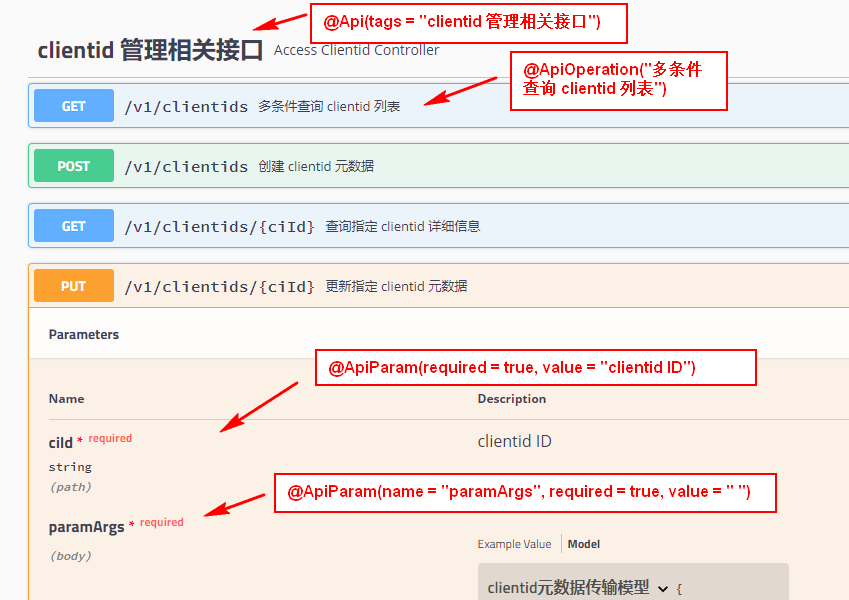Spring boot Swagger2 配置使用实战
今天来说一下 Spring boot 如何集成 Swagger 2,虽然网上有很多这样的教程,但觉得还是应该自己梳理一下,这样对知识的掌握比较牢靠。另外文章中也有我在开发中遇到的问题及解决方法,统一记录下来。
真的比 postman 省心,对于前后端联调、测试、用户来说都很便利。可惜就是代码侵入性太强~ 暂时忍耐。
一、集成 Swagger 2
1、添加 pom.xml 文件依赖
1 | <!-- swagger ui --> |
曾经有一个 spring cloud 项目,用到的 spring boot 版本是 1.x, 用了上述的 2.9.2 版本,添加了 @EnableSwagger2 后,项目启动失败。将版本降低到 2.8.0 后,项目运行正常。测试发现,后两个依赖也可以不用。
2、添加 Swagger java 配置
1 | package com.xxx.xxx.config; |
分析上述配置,我们需要在 java 类上指明 @Configuration、@EnableSwagger2 注解。
另外还需要指定 controller 的包路径。如果需要隐藏 Swagger ui 上的 Models 模块,则需要上面的 uiConfig() 方法。
为了防止 @EnableMvc 把默认的静态资源路径覆盖,还需要上面的 addResourceHandlers() 方法。
紧接着,我们就可以启动项目了,Swagger 2 ui 地址为:http://ip:port/swagger-ui.html 。
二、Swagger 常用注解
- @Api(tags = “xxx相关接口”) :修饰整个类,描述 Controller 的作用。
- @ApiOperation(“xxxx”) :描述 api 接口方法。
- @ApiModel(“访问clientid表”) :当 @RequestParam 参数多的时候,可以用对象来接收参数,通常用在 @RequestBody 的 对象 内。注意:@ApiModel 的 value 值需要保持唯一,否则会出现覆盖的情况。
- @ApiModelProperty(value = “主键”, required = true, hidden = true) :用对象接收参数时,描述 Model 对象的一个字段,也称为属性。
- @ApiIgnore:用于 controller 层、controller 层方法、controller 层方法参数上,表示被 swagger ui 忽略。
- @ApiParam(name = “”, required = true, value = “clientid ID”, hidden = true) :可用于描述单个参数,或者描述 @RequestBody 对象。
- name 为页面上的 Name
- value 为页面上的 Description
- @ApiImplicitParams({
@ApiImplicitParam(name = "name", value = "clientid名称"), @ApiImplicitParam(name = "clientid", value = "clientid编码"), @ApiImplicitParam(name = "description", value = "clientid描述信息") }) :适用于 @RequestParam 参数少的时候,参数多的时候可以用 @ApiModel 和 @ApiModelProperty 。
参考博客:https://www.cnblogs.com/fengli9998/p/7921601.html
三、个人小结
1、Swagger ui 页面上的 body 里面的 Model
注解 @ApiModel 和 @ApiModelProperty 是作用在 javaBean 上的,可以起解释说明,是否必选,是否隐藏的作用。在 swagger-ui 页面上的体现形式如下图所示:

2、controller 层 swagger 相关注解
@Api、@ApiOperation、@ApiParam、@ApiIgnore、@ApiImplicitParams 都是作用在 controller 层的注解。如下图所示:

3、PO、DTO、VO 说明及使用
- PO(Persistant Object) 持久对象,用于表示数据库中的一条记录映射成的 java 对象,可以理解一个 PO 就是数据库中的一条记录;
- DTO(Data Transfer Object)数据传输对象,前端调用时传输。
- VO(Value Object)表现对象,用于表示一个与前端进行交互的 java 对象,只包含前端需要展示的数据。
关于 java 中常见的对象类型简述(DO、BO、DTO、VO、AO、PO)可参考:https://blog.csdn.net/uestcyms/article/details/80244407 。
当有多个 requestparam 参数的时候,我们用 DTO 对象接收参数比较方便,用 DTO 对象来精准无冗余地接收请求参数。
可能这里有朋友会疑问,为什么不用 PO 来接收请求参数呢?
因为 PO 中可能存在冗余字段,如果用 PO 来接收参数的话,冗余字段也会在 Swagger ui 页面上显示,用户体验并不好,所以我们用 DTO 来接收请求参数。
同理,为了避免返回给前端的数据存在冗余字段(即不需要展示的字段),我们可以使用 VO 来接收数据返回给前端进行交互。
点关注,不迷路
好了各位,以上就是这篇文章的全部内容了,能看到这里的人呀,都是人才。
白嫖不好,创作不易。 各位的支持和认可,就是我创作的最大动力,我们下篇文章见!
如果本篇博客有任何错误,请批评指教,不胜感激 !
点关注,不迷路
好了各位,以上就是这篇文章的全部内容了,能看到这里的人呀,都是人才。
白嫖不好,创作不易。各位的支持和认可,就是我创作的最大动力,我们下篇文章见!
如果本篇博客有任何错误,请批评指教,不胜感激 !
原文作者: create17
原文链接: https://841809077.github.io/2020/06/03/Spring boot/swagger2-use-collection.html
版权声明: 转载请注明出处(码字不易,请保留作者署名及链接,谢谢配合!)




